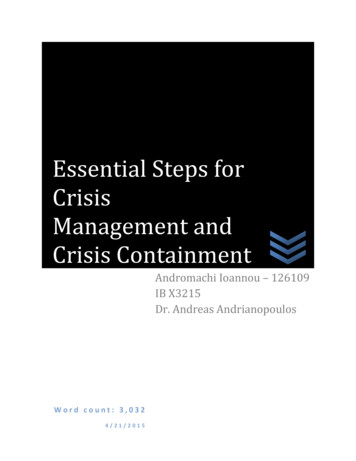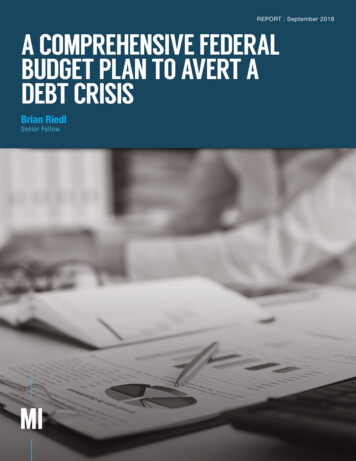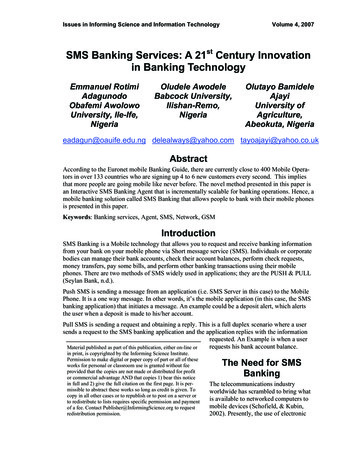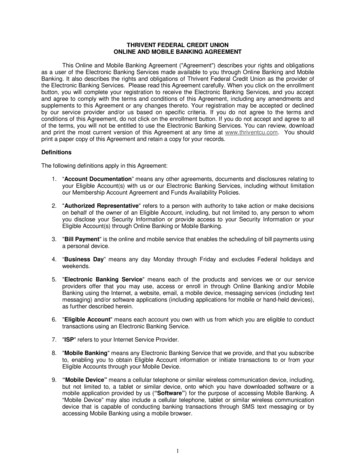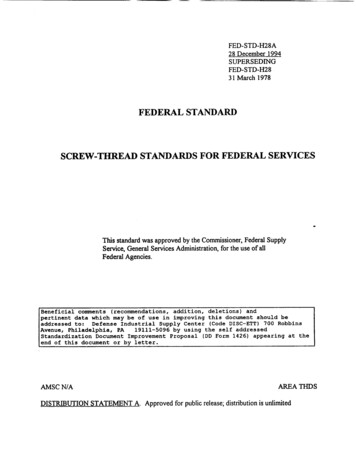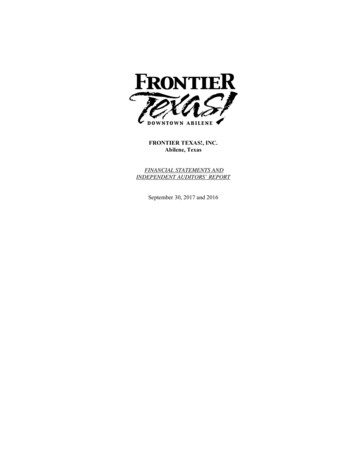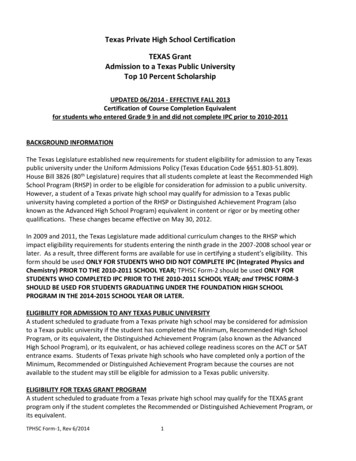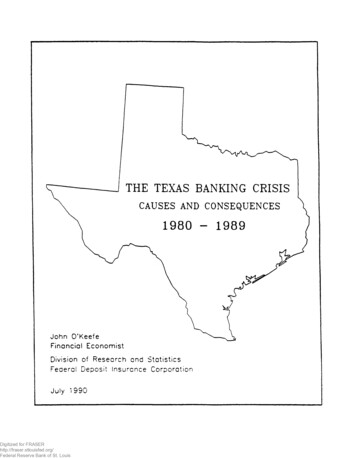
Transcription
THE TEXAS BANKING CRISISCAUSES AND CONSEQUENCES1980John O'KeefeFinancial EconomistDivision of Research ond StatisticsFeaerai Deposit Insurance CorporationJuly 1990Digitized for FRASERhttp://fraser.stlouisfed.org/Federal Reserve Bank of St. Louis-1989
The Texas Banking Crisis: Causes and Consequences(1980 - 1989)John O'KeefeFinancial EconomistFederal Deposit Insurance CorporationI would like to thank Art Murton, Maureen Muldoon, JaneCoburn, Michael Graves and Don Inscoe of the Division of Researchand Statistics for suggestions and assistance.In addition,information and comments received from Division of Supervisionstaff, Bob Miailovich, Bob Walsh, and the staff of the DallasRegional Office were very helpful.As in all such endeavors,responsibility of the author.Digitized for FRASERhttp://fraser.stlouisfed.org/Federal Reserve Bank of St. Louisanyremainingfaultsarethe
Table Of ContentsPageExecutive Summary1SectionI.Introduction3II.Growth Rates among Commercial Banks:Texas versus the U.SIII. Condition and Performance Trends:7Texas versus the U. S11IV.Major Metropolitan Areas14V.Texas Bank Holding Companies17VI. Bank Supervision: Bank Examination and Oversight . 19VII. Funding Bank Activities: The Role of DepositInsurance26AppendicesA.Trends in Lending Activity: Texas versus the U.S. . 29B.Failed Bank Lending Activity: Major MetropolitanAreas41Case Histories: Failed Bank Holding Companies44C.Digitized for FRASERhttp://fraser.stlouisfed.org/Federal Reserve Bank of St. Louis i -
Executive SummaryThe purpose of this analysis is to explain the recent highfailure rates among Texas commercial banks.Specifically, wereviewed financial and nonfinancial market data, as well asinformation regarding regulatory activity in Texas over the pastdecade, in order to determine those factors contributing to therecent problems of the state's commercial banks.BackgroundOver the past decade, 349 Texas commercial banks failed, andan additional 76 required assistance from the FDIC. The number offailed and assisted Texas banks rose from 3 in 1983 to 134 in 1989.In 1988 and 1989 failed and assisted banks (hereafter denotedfailed banks) in the state comprised over 80 percent of total U.S.failed-bank assets, and over 80 percent of total FDIC reserves forlosses on failed banks. In addition, both the domestic energy andlocal commercial real estate markets, in which Texas banks investedheavily, experienced dramatic declines after 1985.Principal Findings- Most Texas commercial banks that failed over the past decadeappear to have reacted quickly to oil price movements.Loanconcentrations in commercial and industrial loans, which includeloans to oil and gas producers, increased as oil prices rose from1978 to 1981. Commercial loan concentrations generally peaked in1982, shortly after oil prices began to drop. These concentrationssubsequently declined along with oil prices.- Texas commercial real estate growth outpaced increases in officeemployment from 1982 to 1987, resulting in a 30 percent officevacancy rate by 1987 for the combined Austin, Dallas, Houston andSan Antonio areas.Failed commercial banks generally increasedconcentrations in construction and land development loans longafter the decline in local real estate markets.- As commercial real estate vacancy rates grew, it appears tedconstruction projects, as evidenced by the growth in loans securedby nonresidential properties. Traditionally, long-term financingof completed commercial properties would have been taken over bynonbank financiers.- Asset growth and increased investment in risky commercial realestate development projects by failed Texas banks were funded byboth insured and uninsured deposits.- The frequency of examinations of failed banks in the Southwesthas been the lowest (for failed banks) in the nation for most ofthe past decade. In addition, the number of bank examinationsDigitized for FRASERhttp://fraser.stlouisfed.org/Federal Reserve Bank of St. Louis
declined significantly in 1984 and 1985 for the nation, and forTexas, in particular.- Once problems became apparent to regulators and the market,retrenchment began at most failing institutions, followed byresolution.Digitized for FRASERhttp://fraser.stlouisfed.org/Federal Reserve Bank of St. Louis
I. Introduction:Over the past decade 349 Texas commercial banks failed and anadditional 76 required assistance from the FDIC. The increase infailure rates among Texas banks coincides with the unprecedentedincrease in the national rate of bank failure in 1984. As shownin Figure 1A, the number of failed and assisted banks (hereafterdenoted failed banks) in Texas approximately doubled each yearbetween 1983 and 1988, increasing from 3 failures in 1983 to 175in 1988 (and 134 in 1989) .These figures may be somewhatmisleading because of the restrictions on branch banking in Texas,which were not removed until 1987. However, with the failure ofmost of Texas1 largest bank holding companies in 1988 and 1989, thedata show a disproportionate amount of failed banks1 assets amongTexas banks (see Figure IB) Digitized for FRASERhttp://fraser.stlouisfed.org/Federal Reserve Bank of St. LouisNuiber of Failed & Assisted BanksPDXC Iasvrod tamks (1980 - 1989)Assets of Failed & Assisted BanksFDIC Iastrtd Btaks (1980 1989)I960I96i196219131964IMStHi196719661969
The increase in failures among Texas commercial banks hasresulted in increases in resolution costs for the FDIC. Figure 1Cshows FDIC loss reserves for banks that failed between 1985 and1989.As expected, the cost of resolving failures in Texas hasbecome a large portion of total resolution costs in recent years.FDIC loss reserves for Texas banks that failed in 1985 were 80.9million, or 9.2 percent of total reserves. The situation changeddramatically by 1988, with FDIC loss reserves on Texas failed banksreaching 4.7 billion, or 88 percent of total FDIC loss reserveson failed banks that year. In 1989, FDIC loss reserves for Texasfailed banks remained high at 4.6 billion, or 81 percent of totalloss reserves for the year's failures.Digitized for FRASERhttp://fraser.stlouisfed.org/Federal Reserve Bank of St. LouisFDIC Loss Reservesrailed and Assisted Banis196519861907Ft Hart YtirFigure 1C196B1989
Historically, the proportional cost of resolving bank failuresdecreases as bank asset size increases. Among banks that failedbetween 1985 and 1989, We find that for banks with assets of 30million or less, FDIC loss reserves averaged 27.3 percent of bankassets, while for banks with assets of 1 billion or more, lossreserves averaged 10.8 percent of bank assets.Figure ID shows FDIC loss reserves as a percentage of failedbank assets for Texas and the rest of the nation. The proportionalcost figures for Texas failed banks have declined in recent years,primarily because recent failures in the state have involved largebank holding companies. In 1988, the failure of First RepublicBankand the assistance of First City Bancorporation comprised most ofthe total failed-bank assets in Texas that year. Similarly, thefailures of MCorp and Texas American Bank comprised most of thefailed-bank assets in Texas in 1989.Digitized for FRASERhttp://fraser.stlouisfed.org/Federal Reserve Bank of St. LouisFDIC Loss Reservesrailed and Assisted Banks19391905Failure TetiFigure ID
The high failure rates among Texas commercial banks appear tobe attributable to a combination of several developments.Thefirst was the trend in crude oil prices (and related products) The OPEC oil embargo of 1973 contributed to large increases indomestic crude oil prices between January 1973 and June 1981.Crude oil prices subsequently declined at a moderate rate frommidyear 1981 to December 1985, then fell dramatically in 1986.(Texas crude oil prices fell 45 percent in 1986.) Crude oil priceshave fluctuated less in recent years, and presently (July 1990)remain below 1980 price levels.The second important development was the boom and bust inTexas real estate; especially, office and land developmentprojects. Following the late 1970s boom in the energy markets,Texas office real estate grew rapidly, as did office employment.However, after the drop in oil prices in 1982, the expansion inoffice space outpaced the growth in office employment and continuedto do so until 1987. Overbuilding in Texas eventually led to 25percent to 30 percent office vacancy rates in the majormetropolitan areas in Texas between 1986 and 1989.The changes in the composition of the loan portfolios of Texascommercial banks appears to be the third factor contributing tothe high failure rates of the late 1980s.Concentrations inconstruction and land development projects among Texas banks grewfrom 3.5 percent of bank assets in 1978 to 8.3 percent of assetsin 1984, and remained at high levels through 1986. Over this sameperiod, nonperforming assets, comprised largely of sbanks.Concentrations in commercial and industrial loans (which includeenergy loans) followed oil price movements, rising from 20.7percent of Texas bank assets in 1978 to 27.8 percent in 1982.However, as oil prices have declined, so too have related loanconcentrations.As of 1989, commercial and industrial loanscomprised 16.54 percent of Texas bank assets.The final significant trend relates to bank examinations.The frequency of examinations of Texas commercial banks was amongthe lowest in the nation for the last decade. Bank examinationswere least frequent in 1984 and 1985 across the country, as wellas in Texas. The lengthening of the exam interval was due, inpart, to hiring freezes and increased workloads for exam staff.These trends also apply to Texas commercial banks which failed1Nonperforming assets are defined as the sum of all loans andleases (hereafter denoted as loans) past due 90 days or more(excluding past due restructured loans), nonaccrual loans, andother real estate owned minus investments in real estate ventures.Nonperforxning real estate loans are defined as the sum of realestate loans past due 90 days or more plus nonaccrual real estateloans.Digitized for FRASERhttp://fraser.stlouisfed.org/Federal Reserve Bank of St. Louis
during the past decade.In the remainder of this study# the recent history of Texascommercial banks is analyzed, as it relates to the increased bankfailure rate in the state. To begin. Section II presents data ongrowth of the commercial banking industry in Texas over the lasttwo decades.Section III contains a summary of financial andnonfinancial market events relevant to Texas commercial bankingproblems. Section IV reviews the activities of failed banks infour major metropolitan areas in Texas.Section V reviews theexperiences of the large bank holding companies in Texas which havefailed in the past decade. Section VI examines the supervisoryactivities of federal bank regulators. Finally, Section VII looksat the role that our present deposit insurance system may haveplayed in the Texas banking crisis.II. Growth Rates among Commercial Banks:Texas versus the U.S.Banking activity in Texas increased greatly during the late1970s and early 1980s.(This paper focuses on FDIC-insuredcommercial bank activity, however, similar growth occurred amongTexas thrifts.) Texas commercial bank asset growth outpaced thenational average from 1977 through 1984 (see Figure 2A) . In 1981,Texas banks' asset growth reached a high of 20.5 percent, comparedto 8.6 percent for all other U.S. banks.Digitized for FRASERhttp://fraser.stlouisfed.org/Federal Reserve Bank of St. LouisAsset Growth Rates of FDIC Insured Commercial Banks(1970 - 1989)OJex.ofc-4o19711973197519771979YearFigure 2A1981198319851987198
Asset growth by Texas banks between 1977 and 1980 occurredprimarily through expansion by existing banks. Subsequent assetgrowth was aided by a large increase in new bank charters (seeTable 1 and Figures 2B and 2C).Table 1New Commercial Bank ChartersX a TexasChartersNumber of 98119821983198419851986198719881989Digitized for FRASERhttp://fraser.stlouisfed.org/Federal Reserve Bank of St. . (except Texas)ChartersNumber of 12,62012,45912,22011,93011,62911,392
Digitized for FRASERhttp://fraser.stlouisfed.org/Federal Reserve Bank of St. LouisNew Commercial Bank Charters(1970 -1989)320300 280 260 240 -Q O«n*\220 -ter!200 ISO -m160 -u140 -o120 -ai100 - 60 60 40 -20 J19701988Texas Commercial BanXs(1970 - 1989)com re X3CJOo 0302010- 1970Texas Bant Assets ( )19721974197619781980YearFigure 2C1982198119861988
Prior to 1987, Texas law prohibited branch banking. Thisresulted in the expansion of bank holding companies as a means toachieve an effective branch banking network in a unit bankingstate. Consequently, some of the increase in chartering in Texasprior to 1987 facilitated the funding of additional growth by bankholding companies. The newly chartered banks within a holdingcompany would be used to gather deposits, which would be channeledto other banks through sales of federal funds or interbankdeposits. The funds purchased from these affiliates would helpfinance additional lending. Much of the new chartering, however,involved small banks not affiliated with the large bank holdingcompanies. Between 1980 and 1989, 673 banks were chartered inTexas, comprising 24 percent of all U.S. bank charters over thisperiod. Of these 673 banks, 511 were national banks, 71 were statechartered, Federal Reserve member banks, and 91 were statechartered, nonmember banks.The major factor contributing to the growth of Texascommercial banks since 1974 has been the condition of domesticenergy markets, gas and crude oil in particular. The importanceof oil prices for the Texas economy has, however, changed over thepast decade. A recent study by the Federal Reserve Bank in Dallasstates that Texas nonagricultural employment follows oil pricemovements with a short lag. In addition, the study concludes thatinflation in oil prices after the OPEC oil embargo of 1973 led toincreased dependency of the Texas economy on crude oil prices until1983. The study also finds that this dependency has mirrored thedecline in oil prices since 1983.Texas bank asset growth also followed oil prices, with a lag.As oil prices rose between 1973 and 1981, so too, did Texas bankassets. The rapid inflation in oil prices in 1980 and 1981 led toaccelerated growth in Texas bank assets. Mild deflation in oilprices between 1982 and 1985 brought Texas bank asset growth ratescloser to those for other U.S. banks. The sharp decline in oilprices in 1986, and the subsequent failures of most of the state'slargest banking organizations, led to a shrinkage of the Texasbanking industry until 1989.One question that is raised by these growth trends is whetherTexas banking markets suffered from "overbanking."The term11over bank ing11 connotes an overall expansion of bank activities thatwas imprudent or unwarranted. Overbanking might therefore becharacterized by excessive asset growth rates, rather than anincrease in any specific type of lending (e.g. growth in commercialreal estate loans) By definition, imprudent asset growth resultsfrom a lowering of credit standards by bankers searching for new2T. Fomby and J. Hirschberg "Texas in Transition: Dependenceon Oil and the National Economy", Federal Reserve Bank of Dallas,Economic Review, January 1989.Digitized for FRASERhttp://fraser.stlouisfed.org/Federal Reserve Bank of St. Louis10
business. Unfortunately, a concise measure of overbanking does notexist. Rapid increases in asset levels or new bank charters do notin themselves imply overbanking.Economic theory predicts thatregardless of the degree of competitiveness in a market, anincrease in demand for products results in increased output levels,other things being equal.The relevant question in this contextis whether the increase in commercial bank activity seen in Figures1 through 3 was imprudent, or merely an appropriate reaction tochanges in market conditions.If Texas financial markets didsuffer from overbanking, the result of increased competition andrelaxed credit standards would be increased failure rates.Failures would include both new and established banks, however,since new institutions typically have greater difficulty facingeconomic stress, one expects a higher failure rate among newerbanks. This was indeed the case. Approximately, 142 institutions,or 21 percent of the Texas banks chartered since 1980 failed. (Thisestimate does not include some of the newly chartered banks thatmerged or were acquired by another institution which subsequentlyfailed.)Given the changing structure of the Texas economy over thepast decade, it would be difficult, if not impossible, to state howmuch the growth in the commercial banking industry was necessary.A simpler task, addressed in the following section, is to examinespecific lending practices and to relate them to events affectingthe region's economy.III. Condition and Performance Trends:Texas versus U.S.The high failure rates among Texas banks in the late 1980s hasits roots in the OPEC oil embargo of 1973. The OPEC oil embargoof 1973 initiated a shortage of crude oil in the U.S. in the winterof 1974. As a result, the price of Texas crude oil more thandoubled in January 1974. West Texas Intermediate crude oil pricesjumped from 4.31 per barrel in December 1973 to 10.11 per barrelin January 1974; an increase of 135 percent in one month.4 Theinfluence of OPEC was, of course, reflected in all domestic crudeoil prices.Figure 3A shows the trend in the average annualdomestic crude oil refiner acquisition cost from 1972 through 1988.After the OPEC oil embargo, domestic crude oil prices rosedramatically, with a 58 percent increase in the average cost ofdomestic crude oil between 1973 and 1974.Domestic crude oilprices grew at a moderate rate until 1979, when another round ofsharp price increases began. Average annual domestic crude oilacquisition costs rose 23.5 percent in 1979, 55.7 percent in 1980,3An exception to this statement is the case of completelyinelastic supply.4Digitized for FRASERhttp://fraser.stlouisfed.org/Federal Reserve Bank of St. LouisSource: Oil and Gas Journal Energy Database,11
and 29.2 percent in 1981. Average crude oil prices declined at amoderate rate between 1982 and 1985, followed by a 45.9 percentdecline in 1986.Since 1986, oil prices have continued tofluctuate, however they have remained below 1980 average prices.(Also see Table 5, Appendix A ) .Crude Oil Refiner Acquisition CostCurrent Dollar. Doiestic9310iroITO irM ltnit?* i?n ltrt i ntwo tttiimIWJ m« i«ts t mltrr ttitYearFigure 3AThe increase in oil prices had an obvious impact on Texas realestate markets. Figure 3B shows trends in Texas office real estatemarkets from 1978 to 1989. In 1981, office starts were more thandouble the level in 1980 for the combined Austin, Dallas, Houstonand San Antonio area. Obviously, 50 percent annual increases incrude oil prices provided strong incentives for business expansion.However, such inflation in oil prices did not persist. Ultimately,the weakening of the OPEC oil cartel, in addition to domesticenergy conservation, led to reductions in oil prices. The buildingtrend in Texas, however, continued into 1986. The overbuilding inTexas commercial real estate resulted in rising office vacancyrates between 1981 and 1989. (Also see Table 6, Appendix A ) .Additional downward pressure on real estate markets came withthe Tax Reform Act of 1986.The 1986 tax law changes greatlyreduced the tax benefits of owning real estate, pa
failed-bank assets, and over 80 percent of total FDIC reserves for losses on failed banks. In addition, both the domestic energy and local commercial real estate markets, in which Texas banks invested heavily, experienced dramatic declines after 1985. Principal Findings - Most Texas c
